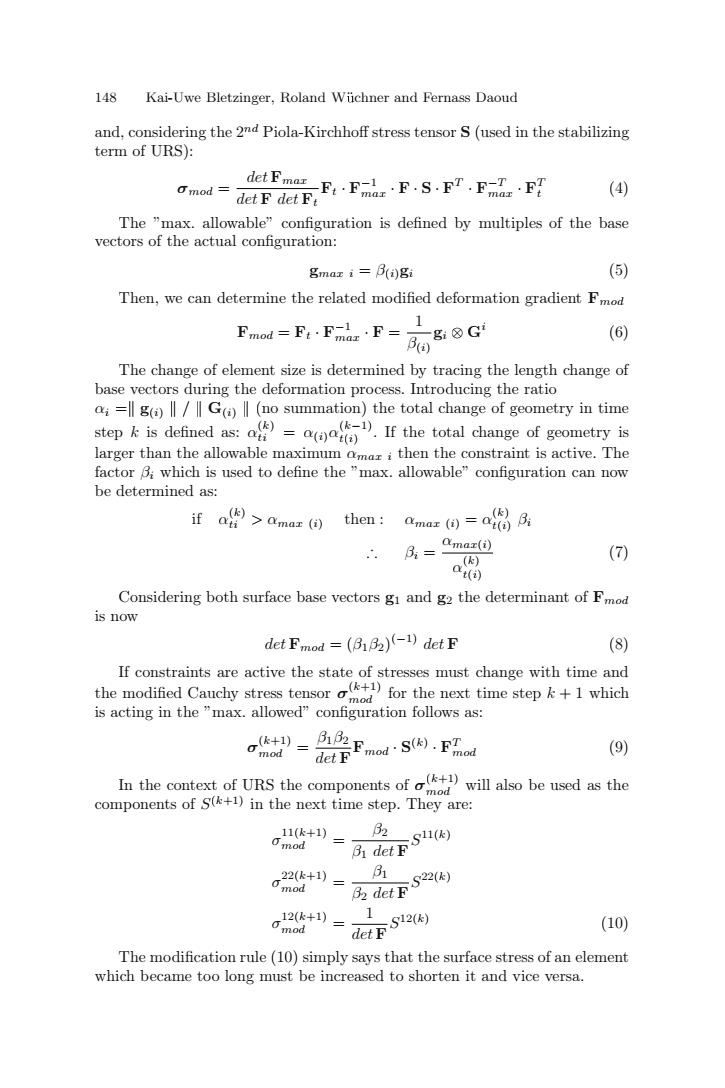正在加载图片...

148 Kai-Uwe Bletzinger,Roland Wuichner and Fernass Daoud and,considering the 2nd Piola-Kirchhoff stress tensor S(used in the stabilizing term of URS): tEnF,EmF.F明 omod=detFdetF (4) The "max.allowable"configuration is defined by multiples of the base vectors of the actual configuration: gmar i=B(i)gi (5) Then,we can determine the related modified deformation gradient Fmod Fmod=EFd·F=1 gi图G (6) The change of element size is determined by tracing the length change of base vectors during the deformation process.Introducing the ratio a=‖g(a‖/|G(o‖(no summation)the total change of geometry in time stepidefined If the total change of geometrys larger than the allowable maximum mai then the constraint is active.The factor Bi which is used to define the "max.allowable"configuration can now be determined as: ifa>amar间then:amar间=a喝属 ..32= (mar(i) 喝 (7) Considering both surface base vectors gi and g2 the determinant of Fmod is now det Fmod =(B1B2)(-1)det F (8) If constraints are active the state of stresses must change with time and the modified Cauchyeten)for the next time step1 which is acting in the "max.allowed"configuration follows as: o(k1) mod mod的.F职od det F (9) In the contet of URS the components ofwill also be usdas the components of S(k+1)in the next time step.They are: o2经+)= 32_S11() B detF 22(k+1)= Omod S22() B2 detF 12(k+1)= Omod deiF) 1 (10) The modification rule (10)simply says that the surface stress of an element which became too long must be increased to shorten it and vice versa.148 Kai-Uwe Bletzinger, Roland W¨uchner and Fernass Daoud ¨ and, considering the 2nd Piola-Kirchhoff stress tensor S (used in the stabilizing term of URS): σmod = det Fmax det F det Ft Ft · F−1 max · F · S · FT · F−T max · FT t (4) The ”max. allowable” configuration is defined by multiples of the base vectors of the actual configuration: gmax i = β(i)gi (5) Then, we can determine the related modified deformation gradient Fmod Fmod = Ft · F−1 max · F = 1 β(i) gi ⊗ Gi (6) The change of element size is determined by tracing the length change of base vectors during the deformation process. Introducing the ratio αi = g(i) / G(i) (no summation) the total change of geometry in time step k is defined as: α(k) ti = α(i)α(k−1) t(i) . If the total change of geometry is larger than the allowable maximum αmax i then the constraint is active. The factor βi which is used to define the ”max. allowable” configuration can now be determined as: if α(k) ti > αmax (i) then : αmax (i) = α(k) t(i) βi ∴ βi = αmax(i) α(k) t(i) (7) Considering both surface base vectors g1 and g2 the determinant of Fmod is now det Fmod = (β1β2) (−1) det F (8) If constraints are active the state of stresses must change with time and the modified Cauchy stress tensor σ(k+1) mod for the next time step k + 1 which is acting in the ”max. allowed” configuration follows as: σ(k+1) mod = β1β2 det F Fmod · S(k) · FT mod (9) In the context of URS the components of σ(k+1) mod will also be used as the components of S(k+1) in the next time step. They are: σ11(k+1) mod = β2 β1 det F S11(k) σ22(k+1) mod = β1 β2 det F S22(k) σ12(k+1) mod = 1 det F S12(k) (10) The modification rule (10) simply says that the surface stress of an element which became too long must be increased to shorten it and vice versa.����